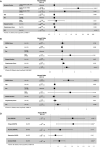Primary Sjögren's syndrome: Longitudinal real-world, observational data on health-related quality of life
- PMID: 35018685
- PMCID: PMC9305875
- DOI: 10.1111/joim.13451
Primary Sjögren's syndrome: Longitudinal real-world, observational data on health-related quality of life
Abstract
Introduction: Primary Sjögren's syndrome (pSS) is a chronic inflammatory condition, which presents with symptoms of dryness, pain, fatigue and often symptoms of anxiety and depression. Health-related quality of life (HRQoL) is significantly reduced in pSS and the direct and indirect health costs of pSS are substantial. This study aims to determine how symptom burden, disease activity and demographics associate with HRQoL longitudinally over a median of 24-month follow-up period in pSS.
Methods: Longitudinal EuroQoL-5 dimension (EQ-5D)-3L data from the Newcastle pSS cohort (n = 377) were evaluated using a survival analysis strategy. Kaplan-Meier and Cox proportional hazards analysis were performed using baseline Newcastle Sjogren's Stratification Tool (NSST) subgroup, EULAR Sjogren's Syndrome Patient Reported Index (ESSPRI), EULAR Sjogren's Syndrome Disease Activity Index (ESSDAI), disease duration, age and sex as covariates including polypharmacy and comorbidity score, where data were available (n = 191).
Results: Of the 377 pSS participants analysed in this study, 16% experienced a decline in HRQoL to a health state comparable to or worse than death. NSST subgroup and ESSPRI score had a significant relationship with time to 'EQ-5D event', whereas baseline ESSDAI, age, disease duration and sex did not.
Conclusion: In pSS, symptom burden and to a great extent NSST subgroup, rather than systemic disease activity, has a significant relationship with HRQoL longitudinally. Improvements in symptom burden have the potential to produce significant impacts on long-term HRQoL in pSS.
Keywords: Sjogren's; health-related quality of life; longitudinal.
© 2022 The Authors. Journal of Internal Medicine published by John Wiley & Sons Ltd on behalf of Association for Publication of The Journal of Internal Medicine.
Conflict of interest statement
None of the authors has competing interests related to the submitted work. Wan‐Fai Ng reports personal fees from GlaxoSmithKline, MedImmune, Novartis and BMS; personal fees and grant support from Abbvie and grant support from Resolves Therapeutics, Nascient, outside of the submitted work.
Figures


References
-
- Tarn JR, Howard‐Tripp N, Lendrem DW, Mariette X, Saraux A, Devauchelle‐Pensec V, et al. Symptom‐based stratification of patients with primary Sjögren's syndrome: multi‐dimensional characterisation of international observational cohorts and reanalyses of randomised clinical trials. Lancet Rheumatology. 2019;1(2):e85–94. 10.1016/S2665-9913(19)30042-6 - DOI - PMC - PubMed
Publication types
MeSH terms
Grants and funding
LinkOut - more resources
Full Text Sources
Medical

